Point group
In geometry, a point group is a group of geometric symmetries (isometries) that keep at least one point fixed. Point groups can exist in a Euclidean space with any dimension, and every point group in dimension d is a subgroup of the orthogonal group O(d). Point groups can be realized as sets of orthogonal matrices M that transform point x into point y:
- y = Mx
 The Bauhinia blakeana flower on the Hong Kong region flag has C5 symmetry; the star on each petal has D5 symmetry. |
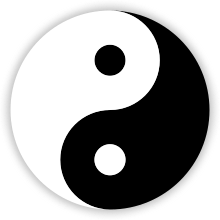 The Yin and Yang symbol has C2 symmetry of geometry with inverted colors |
where the origin is the fixed point. Point-group elements can either be rotations (determinant of M = 1) or else reflections, or improper rotations (determinant of M = −1).
Discrete point groups in more than one dimension come in infinite families, but from the crystallographic restriction theorem and one of Bieberbach's theorems, each number of dimensions has only a finite number of point groups that are symmetric over some lattice or grid with that number. These are the crystallographic point groups.
Chiral and achiral point groups, reflection groups
Point groups can be classified into chiral (or purely rotational) groups and achiral groups.[1] The chiral groups are subgroups of the special orthogonal group SO(d): they contain only orientation-preserving orthogonal transformations, i.e., those of determinant +1. The achiral groups contain also transformations of determinant −1. In an achiral group, the orientation-preserving transformations form a (chiral) subgroup of index 2.
Finite Coxeter groups or reflection groups are those point groups that are generated purely by a set of reflectional mirrors passing through the same point. A rank n Coxeter group has n mirrors and is represented by a Coxeter-Dynkin diagram. Coxeter notation offers a bracketed notation equivalent to the Coxeter diagram, with markup symbols for rotational and other subsymmetry point groups. Reflection groups are necessarily achiral (except for the trivial group containing only the identity element).
List of point groups
One dimension
There are only two one-dimensional point groups, the identity group and the reflection group.
| Group | Coxeter | Coxeter diagram | Order | Description |
|---|---|---|---|---|
| C1 | [ ]+ | 1 | Identity | |
| D1 | [ ] | 2 | Reflection group |
Two dimensions
Point groups in two dimensions, sometimes called rosette groups.
They come in two infinite families:
- Cyclic groups Cn of n-fold rotation groups
- Dihedral groups Dn of n-fold rotation and reflection groups
Applying the crystallographic restriction theorem restricts n to values 1, 2, 3, 4, and 6 for both families, yielding 10 groups.
| Group | Intl | Orbifold | Coxeter | Order | Description |
|---|---|---|---|---|---|
| Cn | n | n• | [n]+ | n | Cyclic: n-fold rotations. Abstract group Zn, the group of integers under addition modulo n. |
| Dn | nm | *n• | [n] | 2n | Dihedral: cyclic with reflections. Abstract group Dihn, the dihedral group. |
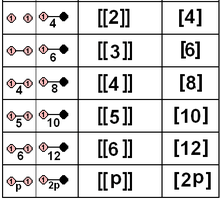
The subset of pure reflectional point groups, defined by 1 or 2 mirrors, can also be given by their Coxeter group and related polygons. These include 5 crystallographic groups. The symmetry of the reflectional groups can be doubled by an isomorphism, mapping both mirrors onto each other by a bisecting mirror, doubling the symmetry order.
| Reflective | Rotational | Related polygons | |||||||
|---|---|---|---|---|---|---|---|---|---|
| Group | Coxeter group | Coxeter diagram | Order | Subgroup | Coxeter | Order | |||
| D1 | A1 | [ ] | 2 | C1 | []+ | 1 | Digon | ||
| D2 | A12 | [2] | 4 | C2 | [2]+ | 2 | Rectangle | ||
| D3 | A2 | [3] | 6 | C3 | [3]+ | 3 | Equilateral triangle | ||
| D4 | BC2 | [4] | 8 | C4 | [4]+ | 4 | Square | ||
| D5 | H2 | [5] | 10 | C5 | [5]+ | 5 | Regular pentagon | ||
| D6 | G2 | [6] | 12 | C6 | [6]+ | 6 | Regular hexagon | ||
| Dn | I2(n) | [n] | 2n | Cn | [n]+ | n | Regular polygon | ||
| D2×2 | A12×2 | [[2]] = [4] | 8 | ||||||
| D3×2 | A2×2 | [[3]] = [6] | 12 | ||||||
| D4×2 | BC2×2 | [[4]] = [8] | 16 | ||||||
| D5×2 | H2×2 | [[5]] = [10] | 20 | ||||||
| D6×2 | G2×2 | [[6]] = [12] | 24 | ||||||
| Dn×2 | I2(n)×2 | [[n]] = [2n] | 4n | ||||||
Three dimensions
Point groups in three dimensions, sometimes called molecular point groups after their wide use in studying the symmetries of small molecules.
They come in 7 infinite families of axial or prismatic groups, and 7 additional polyhedral or Platonic groups. In Schönflies notation,*
- Axial groups: Cn, S2n, Cnh, Cnv, Dn, Dnd, Dnh
- Polyhedral groups: T, Td, Th, O, Oh, I, Ih
Applying the crystallographic restriction theorem to these groups yields 32 Crystallographic point groups.
| C1v Order 2 |
C2v Order 4 |
C3v Order 6 |
C4v Order 8 |
C5v Order 10 |
C6v Order 12 |
... |
|---|---|---|---|---|---|---|
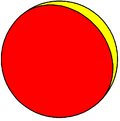 |
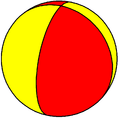 |
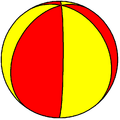 |
 |
 |
 | |
| D1h Order 4 |
D2h Order 8 |
D3h Order 12 |
D4h Order 16 |
D5h Order 20 |
D6h Order 24 |
... |
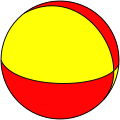 |
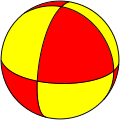 |
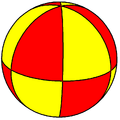 |
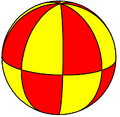 |
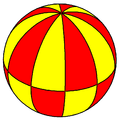 |
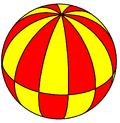 | |
| Td Order 24 |
Oh Order 48 |
Ih Order 120 | ||||
 |
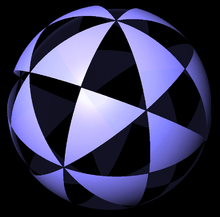 |
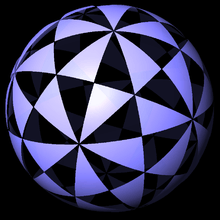 |
|
| |||||||||||||||||||||||||||||||||||||||||||||||||||||||||||||||||||||||||||||||||||||||||||||||||||||||||||||||||||||||||||||||||||||
| (*) When the Intl entries are duplicated, the first is for even n, the second for odd n. | ||||||||||||||||||||||||||||||||||||||||||||||||||||||||||||||||||||||||||||||||||||||||||||||||||||||||||||||||||||||||||||||||||||||
Reflection groups
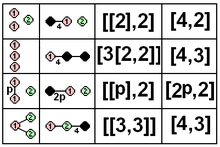
The reflection point groups, defined by 1 to 3 mirror planes, can also be given by their Coxeter group and related polyhedra. The [3,3] group can be doubled, written as [[3,3]], mapping the first and last mirrors onto each other, doubling the symmetry to 48, and isomorphic to the [4,3] group.
| Schönflies | Coxeter group | Coxeter diagram | Order | Related regular and prismatic polyhedra | |||
|---|---|---|---|---|---|---|---|
| Td | A3 | [3,3] | 24 | Tetrahedron | |||
| Td×Dih1 = Oh | A3×2 = BC3 | [[3,3]] = [4,3] | = | 48 | Stellated octahedron | ||
| Oh | BC3 | [4,3] | 48 | Cube, octahedron | |||
| Ih | H3 | [5,3] | 120 | Icosahedron, dodecahedron | |||
| D3h | A2×A1 | [3,2] | 12 | Triangular prism | |||
| D3h×Dih1 = D6h | A2×A1×2 | [[3],2] | = | 24 | Hexagonal prism | ||
| D4h | BC2×A1 | [4,2] | 16 | Square prism | |||
| D4h×Dih1 = D8h | BC2×A1×2 | [[4],2] = [8,2] | = | 32 | Octagonal prism | ||
| D5h | H2×A1 | [5,2] | 20 | Pentagonal prism | |||
| D6h | G2×A1 | [6,2] | 24 | Hexagonal prism | |||
| Dnh | I2(n)×A1 | [n,2] | 4n | n-gonal prism | |||
| Dnh×Dih1 = D2nh | I2(n)×A1×2 | [[n],2] | = | 8n | |||
| D2h | A13 | [2,2] | 8 | Cuboid | |||
| D2h×Dih1 | A13×2 | [[2],2] = [4,2] | = | 16 | |||
| D2h×Dih3 = Oh | A13×6 | [3[2,2]] = [4,3] | = | 48 | |||
| C3v | A2 | [1,3] | 6 | Hosohedron | |||
| C4v | BC2 | [1,4] | 8 | ||||
| C5v | H2 | [1,5] | 10 | ||||
| C6v | G2 | [1,6] | 12 | ||||
| Cnv | I2(n) | [1,n] | 2n | ||||
| Cnv×Dih1 = C2nv | I2(n)×2 | [1,[n]] = [1,2n] | = | 4n | |||
| C2v | A12 | [1,2] | 4 | ||||
| C2v×Dih1 | A12×2 | [1,[2]] | = | 8 | |||
| Cs | A1 | [1,1] | 2 | ||||
Four dimensions
The four-dimensional point groups (chiral as well as achiral) are listed in Conway and Smith,[1] Section 4, Tables 4.1-4.3.
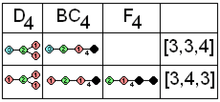
The following list gives the four-dimensional reflection groups (excluding those that leave a subspace fixed and that are therefore lower-dimensional reflection groups). Each group is specified as a Coxeter group, and like the polyhedral groups of 3D, it can be named by its related convex regular 4-polytope. Related pure rotational groups exist for each with half the order, and can be represented by the bracket Coxeter notation with a '+' exponent, for example [3,3,3]+ has three 3-fold gyration points and symmetry order 60. Front-back symmetric groups like [3,3,3] and [3,4,3] can be doubled, shown as double brackets in Coxeter's notation, for example [[3,3,3]] with its order doubled to 240.
| Coxeter group/notation | Coxeter diagram | Order | Related polytopes | ||
|---|---|---|---|---|---|
| A4 | [3,3,3] | 120 | 5-cell | ||
| A4×2 | [[3,3,3]] | 240 | 5-cell dual compound | ||
| BC4 | [4,3,3] | 384 | 16-cell/Tesseract | ||
| D4 | [31,1,1] | 192 | Demitesseractic | ||
| D4×2 = BC4 | <[3,31,1]> = [4,3,3] | = | 384 | ||
| D4×6 = F4 | [3[31,1,1]] = [3,4,3] | = | 1152 | ||
| F4 | [3,4,3] | 1152 | 24-cell | ||
| F4×2 | [[3,4,3]] | 2304 | 24-cell dual compound | ||
| H4 | [5,3,3] | 14400 | 120-cell/600-cell | ||
| A3×A1 | [3,3,2] | 48 | Tetrahedral prism | ||
| A3×A1×2 | [[3,3],2] = [4,3,2] | = | 96 | Octahedral prism | |
| BC3×A1 | [4,3,2] | 96 | |||
| H3×A1 | [5,3,2] | 240 | Icosahedral prism | ||
| A2×A2 | [3,2,3] | 36 | Duoprism | ||
| A2×BC2 | [3,2,4] | 48 | |||
| A2×H2 | [3,2,5] | 60 | |||
| A2×G2 | [3,2,6] | 72 | |||
| BC2×BC2 | [4,2,4] | 64 | |||
| BC22×2 | [[4,2,4]] | 128 | |||
| BC2×H2 | [4,2,5] | 80 | |||
| BC2×G2 | [4,2,6] | 96 | |||
| H2×H2 | [5,2,5] | 100 | |||
| H2×G2 | [5,2,6] | 120 | |||
| G2×G2 | [6,2,6] | 144 | |||
| I2(p)×I2(q) | [p,2,q] | 4pq | |||
| I2(2p)×I2(q) | [[p],2,q] = [2p,2,q] | = | 8pq | ||
| I2(2p)×I2(2q) | [[p]],2,[[q]] = [2p,2,2q] | = | 16pq | ||
| I2(p)2×2 | [[p,2,p]] | 8p2 | |||
| I2(2p)2×2 | [[[p],2,[p]]] = [[2p,2,2p]] | = | 32p2 | ||
| A2×A1×A1 | [3,2,2] | 24 | |||
| BC2×A1×A1 | [4,2,2] | 32 | |||
| H2×A1×A1 | [5,2,2] | 40 | |||
| G2×A1×A1 | [6,2,2] | 48 | |||
| I2(p)×A1×A1 | [p,2,2] | 8p | |||
| I2(2p)×A1×A1×2 | [[p],2,2] = [2p,2,2] | = | 16p | ||
| I2(p)×A12×2 | [p,2,[2]] = [p,2,4] | = | 16p | ||
| I2(2p)×A12×4 | [[p]],2,[[2]] = [2p,2,4] | = | 32p | ||
| A1×A1×A1×A1 | [2,2,2] | 16 | 4-orthotope | ||
| A12×A1×A1×2 | [[2],2,2] = [4,2,2] | = | 32 | ||
| A12×A12×4 | [[2]],2,[[2]] = [4,2,4] | = | 64 | ||
| A13×A1×6 | [3[2,2],2] = [4,3,2] | = | 96 | ||
| A14×24 | [3,3[2,2,2]] = [4,3,3] | = | 384 | ||
Five dimensions

The following table gives the five-dimensional reflection groups (excluding those that are lower-dimensional reflection groups), by listing them as Coxeter groups. Related chiral groups exist for each with half the order, and can be represented by the bracket Coxeter notation with a '+' exponent, for example [3,3,3,3]+ has four 3-fold gyration points and symmetry order 360.
| Coxeter group/notation | Coxeter diagrams |
Order | Related regular and prismatic polytopes | ||
|---|---|---|---|---|---|
| A5 | [3,3,3,3] | 720 | 5-simplex | ||
| A5×2 | [[3,3,3,3]] | 1440 | 5-simplex dual compound | ||
| BC5 | [4,3,3,3] | 3840 | 5-cube, 5-orthoplex | ||
| D5 | [32,1,1] | 1920 | 5-demicube | ||
| D5×2 | <[3,3,31,1]> | 3840 | |||
| A4×A1 | [3,3,3,2] | 240 | 5-cell prism | ||
| A4×A1×2 | [[3,3,3],2] | 480 | |||
| BC4×A1 | [4,3,3,2] | 768 | tesseract prism | ||
| F4×A1 | [3,4,3,2] | 2304 | 24-cell prism | ||
| F4×A1×2 | [[3,4,3],2] | 4608 | |||
| H4×A1 | [5,3,3,2] | 28800 | 600-cell or 120-cell prism | ||
| D4×A1 | [31,1,1,2] | 384 | Demitesseract prism | ||
| A3×A2 | [3,3,2,3] | 144 | Duoprism | ||
| A3×A2×2 | [[3,3],2,3] | 288 | |||
| A3×BC2 | [3,3,2,4] | 192 | |||
| A3×H2 | [3,3,2,5] | 240 | |||
| A3×G2 | [3,3,2,6] | 288 | |||
| A3×I2(p) | [3,3,2,p] | 48p | |||
| BC3×A2 | [4,3,2,3] | 288 | |||
| BC3×BC2 | [4,3,2,4] | 384 | |||
| BC3×H2 | [4,3,2,5] | 480 | |||
| BC3×G2 | [4,3,2,6] | 576 | |||
| BC3×I2(p) | [4,3,2,p] | 96p | |||
| H3×A2 | [5,3,2,3] | 720 | |||
| H3×BC2 | [5,3,2,4] | 960 | |||
| H3×H2 | [5,3,2,5] | 1200 | |||
| H3×G2 | [5,3,2,6] | 1440 | |||
| H3×I2(p) | [5,3,2,p] | 240p | |||
| A3×A12 | [3,3,2,2] | 96 | |||
| BC3×A12 | [4,3,2,2] | 192 | |||
| H3×A12 | [5,3,2,2] | 480 | |||
| A22×A1 | [3,2,3,2] | 72 | duoprism prism | ||
| A2×BC2×A1 | [3,2,4,2] | 96 | |||
| A2×H2×A1 | [3,2,5,2] | 120 | |||
| A2×G2×A1 | [3,2,6,2] | 144 | |||
| BC22×A1 | [4,2,4,2] | 128 | |||
| BC2×H2×A1 | [4,2,5,2] | 160 | |||
| BC2×G2×A1 | [4,2,6,2] | 192 | |||
| H22×A1 | [5,2,5,2] | 200 | |||
| H2×G2×A1 | [5,2,6,2] | 240 | |||
| G22×A1 | [6,2,6,2] | 288 | |||
| I2(p)×I2(q)×A1 | [p,2,q,2] | 8pq | |||
| A2×A13 | [3,2,2,2] | 48 | |||
| BC2×A13 | [4,2,2,2] | 64 | |||
| H2×A13 | [5,2,2,2] | 80 | |||
| G2×A13 | [6,2,2,2] | 96 | |||
| I2(p)×A13 | [p,2,2,2] | 16p | |||
| A15 | [2,2,2,2] | 32 | 5-orthotope | ||
| A15×(2!) | [[2],2,2,2] | 64 | |||
| A15×(2!×2!) | [[2]],2,[2],2] | 128 | |||
| A15×(3!) | [3[2,2],2,2] | 192 | |||
| A15×(3!×2!) | [3[2,2],2,[[2]] | 384 | |||
| A15×(4!) | [3,3[2,2,2],2]] | 768 | |||
| A15×(5!) | [3,3,3[2,2,2,2]] | 3840 | |||
Six dimensions

The following table gives the six-dimensional reflection groups (excluding those that are lower-dimensional reflection groups), by listing them as Coxeter groups. Related pure rotational groups exist for each with half the order, and can be represented by the bracket Coxeter notation with a '+' exponent, for example [3,3,3,3,3]+ has five 3-fold gyration points and symmetry order 2520.
| Coxeter group | Coxeter diagram |
Order | Related regular and prismatic polytopes | |
|---|---|---|---|---|
| A6 | [3,3,3,3,3] | 5040 (7!) | 6-simplex | |
| A6×2 | [[3,3,3,3,3]] | 10080 (2×7!) | 6-simplex dual compound | |
| BC6 | [4,3,3,3,3] | 46080 (26×6!) | 6-cube, 6-orthoplex | |
| D6 | [3,3,3,31,1] | 23040 (25×6!) | 6-demicube | |
| E6 | [3,32,2] | 51840 (72×6!) | 122, 221 | |
| A5×A1 | [3,3,3,3,2] | 1440 (2×6!) | 5-simplex prism | |
| BC5×A1 | [4,3,3,3,2] | 7680 (26×5!) | 5-cube prism | |
| D5×A1 | [3,3,31,1,2] | 3840 (25×5!) | 5-demicube prism | |
| A4×I2(p) | [3,3,3,2,p] | 240p | Duoprism | |
| BC4×I2(p) | [4,3,3,2,p] | 768p | ||
| F4×I2(p) | [3,4,3,2,p] | 2304p | ||
| H4×I2(p) | [5,3,3,2,p] | 28800p | ||
| D4×I2(p) | [3,31,1,2,p] | 384p | ||
| A4×A12 | [3,3,3,2,2] | 480 | ||
| BC4×A12 | [4,3,3,2,2] | 1536 | ||
| F4×A12 | [3,4,3,2,2] | 4608 | ||
| H4×A12 | [5,3,3,2,2] | 57600 | ||
| D4×A12 | [3,31,1,2,2] | 768 | ||
| A32 | [3,3,2,3,3] | 576 | ||
| A3×BC3 | [3,3,2,4,3] | 1152 | ||
| A3×H3 | [3,3,2,5,3] | 2880 | ||
| BC32 | [4,3,2,4,3] | 2304 | ||
| BC3×H3 | [4,3,2,5,3] | 5760 | ||
| H32 | [5,3,2,5,3] | 14400 | ||
| A3×I2(p)×A1 | [3,3,2,p,2] | 96p | Duoprism prism | |
| BC3×I2(p)×A1 | [4,3,2,p,2] | 192p | ||
| H3×I2(p)×A1 | [5,3,2,p,2] | 480p | ||
| A3×A13 | [3,3,2,2,2] | 192 | ||
| BC3×A13 | [4,3,2,2,2] | 384 | ||
| H3×A13 | [5,3,2,2,2] | 960 | ||
| I2(p)×I2(q)×I2(r) | [p,2,q,2,r] | 8pqr | Triaprism | |
| I2(p)×I2(q)×A12 | [p,2,q,2,2] | 16pq | ||
| I2(p)×A14 | [p,2,2,2,2] | 32p | ||
| A16 | [2,2,2,2,2] | 64 | 6-orthotope | |
Seven dimensions
The following table gives the seven-dimensional reflection groups (excluding those that are lower-dimensional reflection groups), by listing them as Coxeter groups. Related chiral groups exist for each with half the order, defined by an even number of reflections, and can be represented by the bracket Coxeter notation with a '+' exponent, for example [3,3,3,3,3,3]+ has six 3-fold gyration points and symmetry order 20160.
| Coxeter group | Coxeter diagram | Order | Related polytopes | |
|---|---|---|---|---|
| A7 | [3,3,3,3,3,3] | 40320 (8!) | 7-simplex | |
| A7×2 | [[3,3,3,3,3,3]] | 80640 (2×8!) | 7-simplex dual compound | |
| BC7 | [4,3,3,3,3,3] | 645120 (27×7!) | 7-cube, 7-orthoplex | |
| D7 | [3,3,3,3,31,1] | 322560 (26×7!) | 7-demicube | |
| E7 | [3,3,3,32,1] | 2903040 (8×9!) | 321, 231, 132 | |
| A6×A1 | [3,3,3,3,3,2] | 10080 (2×7!) | ||
| BC6×A1 | [4,3,3,3,3,2] | 92160 (27×6!) | ||
| D6×A1 | [3,3,3,31,1,2] | 46080 (26×6!) | ||
| E6×A1 | [3,3,32,1,2] | 103680 (144×6!) | ||
| A5×I2(p) | [3,3,3,3,2,p] | 1440p | ||
| BC5×I2(p) | [4,3,3,3,2,p] | 7680p | ||
| D5×I2(p) | [3,3,31,1,2,p] | 3840p | ||
| A5×A12 | [3,3,3,3,2,2] | 2880 | ||
| BC5×A12 | [4,3,3,3,2,2] | 15360 | ||
| D5×A12 | [3,3,31,1,2,2] | 7680 | ||
| A4×A3 | [3,3,3,2,3,3] | 2880 | ||
| A4×BC3 | [3,3,3,2,4,3] | 5760 | ||
| A4×H3 | [3,3,3,2,5,3] | 14400 | ||
| BC4×A3 | [4,3,3,2,3,3] | 9216 | ||
| BC4×BC3 | [4,3,3,2,4,3] | 18432 | ||
| BC4×H3 | [4,3,3,2,5,3] | 46080 | ||
| H4×A3 | [5,3,3,2,3,3] | 345600 | ||
| H4×BC3 | [5,3,3,2,4,3] | 691200 | ||
| H4×H3 | [5,3,3,2,5,3] | 1728000 | ||
| F4×A3 | [3,4,3,2,3,3] | 27648 | ||
| F4×BC3 | [3,4,3,2,4,3] | 55296 | ||
| F4×H3 | [3,4,3,2,5,3] | 138240 | ||
| D4×A3 | [31,1,1,2,3,3] | 4608 | ||
| D4×BC3 | [3,31,1,2,4,3] | 9216 | ||
| D4×H3 | [3,31,1,2,5,3] | 23040 | ||
| A4×I2(p)×A1 | [3,3,3,2,p,2] | 480p | ||
| BC4×I2(p)×A1 | [4,3,3,2,p,2] | 1536p | ||
| D4×I2(p)×A1 | [3,31,1,2,p,2] | 768p | ||
| F4×I2(p)×A1 | [3,4,3,2,p,2] | 4608p | ||
| H4×I2(p)×A1 | [5,3,3,2,p,2] | 57600p | ||
| A4×A13 | [3,3,3,2,2,2] | 960 | ||
| BC4×A13 | [4,3,3,2,2,2] | 3072 | ||
| F4×A13 | [3,4,3,2,2,2] | 9216 | ||
| H4×A13 | [5,3,3,2,2,2] | 115200 | ||
| D4×A13 | [3,31,1,2,2,2] | 1536 | ||
| A32×A1 | [3,3,2,3,3,2] | 1152 | ||
| A3×BC3×A1 | [3,3,2,4,3,2] | 2304 | ||
| A3×H3×A1 | [3,3,2,5,3,2] | 5760 | ||
| BC32×A1 | [4,3,2,4,3,2] | 4608 | ||
| BC3×H3×A1 | [4,3,2,5,3,2] | 11520 | ||
| H32×A1 | [5,3,2,5,3,2] | 28800 | ||
| A3×I2(p)×I2(q) | [3,3,2,p,2,q] | 96pq | ||
| BC3×I2(p)×I2(q) | [4,3,2,p,2,q] | 192pq | ||
| H3×I2(p)×I2(q) | [5,3,2,p,2,q] | 480pq | ||
| A3×I2(p)×A12 | [3,3,2,p,2,2] | 192p | ||
| BC3×I2(p)×A12 | [4,3,2,p,2,2] | 384p | ||
| H3×I2(p)×A12 | [5,3,2,p,2,2] | 960p | ||
| A3×A14 | [3,3,2,2,2,2] | 384 | ||
| BC3×A14 | [4,3,2,2,2,2] | 768 | ||
| H3×A14 | [5,3,2,2,2,2] | 1920 | ||
| I2(p)×I2(q)×I2(r)×A1 | [p,2,q,2,r,2] | 16pqr | ||
| I2(p)×I2(q)×A13 | [p,2,q,2,2,2] | 32pq | ||
| I2(p)×A15 | [p,2,2,2,2,2] | 64p | ||
| A17 | [2,2,2,2,2,2] | 128 | ||
Eight dimensions
The following table gives the eight-dimensional reflection groups (excluding those that are lower-dimensional reflection groups), by listing them as Coxeter groups. Related chiral groups exist for each with half the order, defined by an even number of reflections, and can be represented by the bracket Coxeter notation with a '+' exponent, for example [3,3,3,3,3,3,3]+ has seven 3-fold gyration points and symmetry order 181440.
| Coxeter group | Coxeter diagram | Order | Related polytopes | |
|---|---|---|---|---|
| A8 | [3,3,3,3,3,3,3] | 362880 (9!) | 8-simplex | |
| A8×2 | [[3,3,3,3,3,3,3]] | 725760 (2×9!) | 8-simplex dual compound | |
| BC8 | [4,3,3,3,3,3,3] | 10321920 (288!) | 8-cube,8-orthoplex | |
| D8 | [3,3,3,3,3,31,1] | 5160960 (278!) | 8-demicube | |
| E8 | [3,3,3,3,32,1] | 696729600 (192×10!) | 421, 241, 142 | |
| A7×A1 | [3,3,3,3,3,3,2] | 80640 | 7-simplex prism | |
| BC7×A1 | [4,3,3,3,3,3,2] | 645120 | 7-cube prism | |
| D7×A1 | [3,3,3,3,31,1,2] | 322560 | 7-demicube prism | |
| E7×A1 | [3,3,3,32,1,2] | 5806080 | 321 prism, 231 prism, 142 prism | |
| A6×I2(p) | [3,3,3,3,3,2,p] | 10080p | duoprism | |
| BC6×I2(p) | [4,3,3,3,3,2,p] | 92160p | ||
| D6×I2(p) | [3,3,3,31,1,2,p] | 46080p | ||
| E6×I2(p) | [3,3,32,1,2,p] | 103680p | ||
| A6×A12 | [3,3,3,3,3,2,2] | 20160 | ||
| BC6×A12 | [4,3,3,3,3,2,2] | 184320 | ||
| D6×A12 | [33,1,1,2,2] | 92160 | ||
| E6×A12 | [3,3,32,1,2,2] | 207360 | ||
| A5×A3 | [3,3,3,3,2,3,3] | 17280 | ||
| BC5×A3 | [4,3,3,3,2,3,3] | 92160 | ||
| D5×A3 | [32,1,1,2,3,3] | 46080 | ||
| A5×BC3 | [3,3,3,3,2,4,3] | 34560 | ||
| BC5×BC3 | [4,3,3,3,2,4,3] | 184320 | ||
| D5×BC3 | [32,1,1,2,4,3] | 92160 | ||
| A5×H3 | [3,3,3,3,2,5,3] | |||
| BC5×H3 | [4,3,3,3,2,5,3] | |||
| D5×H3 | [32,1,1,2,5,3] | |||
| A5×I2(p)×A1 | [3,3,3,3,2,p,2] | |||
| BC5×I2(p)×A1 | [4,3,3,3,2,p,2] | |||
| D5×I2(p)×A1 | [32,1,1,2,p,2] | |||
| A5×A13 | [3,3,3,3,2,2,2] | |||
| BC5×A13 | [4,3,3,3,2,2,2] | |||
| D5×A13 | [32,1,1,2,2,2] | |||
| A4×A4 | [3,3,3,2,3,3,3] | |||
| BC4×A4 | [4,3,3,2,3,3,3] | |||
| D4×A4 | [31,1,1,2,3,3,3] | |||
| F4×A4 | [3,4,3,2,3,3,3] | |||
| H4×A4 | [5,3,3,2,3,3,3] | |||
| BC4×BC4 | [4,3,3,2,4,3,3] | |||
| D4×BC4 | [31,1,1,2,4,3,3] | |||
| F4×BC4 | [3,4,3,2,4,3,3] | |||
| H4×BC4 | [5,3,3,2,4,3,3] | |||
| D4×D4 | [31,1,1,2,31,1,1] | |||
| F4×D4 | [3,4,3,2,31,1,1] | |||
| H4×D4 | [5,3,3,2,31,1,1] | |||
| F4×F4 | [3,4,3,2,3,4,3] | |||
| H4×F4 | [5,3,3,2,3,4,3] | |||
| H4×H4 | [5,3,3,2,5,3,3] | |||
| A4×A3×A1 | [3,3,3,2,3,3,2] | duoprism prisms | ||
| A4×BC3×A1 | [3,3,3,2,4,3,2] | |||
| A4×H3×A1 | [3,3,3,2,5,3,2] | |||
| BC4×A3×A1 | [4,3,3,2,3,3,2] | |||
| BC4×BC3×A1 | [4,3,3,2,4,3,2] | |||
| BC4×H3×A1 | [4,3,3,2,5,3,2] | |||
| H4×A3×A1 | [5,3,3,2,3,3,2] | |||
| H4×BC3×A1 | [5,3,3,2,4,3,2] | |||
| H4×H3×A1 | [5,3,3,2,5,3,2] | |||
| F4×A3×A1 | [3,4,3,2,3,3,2] | |||
| F4×BC3×A1 | [3,4,3,2,4,3,2] | |||
| F4×H3×A1 | [3,4,2,3,5,3,2] | |||
| D4×A3×A1 | [31,1,1,2,3,3,2] | |||
| D4×BC3×A1 | [31,1,1,2,4,3,2] | |||
| D4×H3×A1 | [31,1,1,2,5,3,2] | |||
| A4×I2(p)×I2(q) | [3,3,3,2,p,2,q] | triaprism | ||
| BC4×I2(p)×I2(q) | [4,3,3,2,p,2,q] | |||
| F4×I2(p)×I2(q) | [3,4,3,2,p,2,q] | |||
| H4×I2(p)×I2(q) | [5,3,3,2,p,2,q] | |||
| D4×I2(p)×I2(q) | [31,1,1,2,p,2,q] | |||
| A4×I2(p)×A12 | [3,3,3,2,p,2,2] | |||
| BC4×I2(p)×A12 | [4,3,3,2,p,2,2] | |||
| F4×I2(p)×A12 | [3,4,3,2,p,2,2] | |||
| H4×I2(p)×A12 | [5,3,3,2,p,2,2] | |||
| D4×I2(p)×A12 | [31,1,1,2,p,2,2] | |||
| A4×A14 | [3,3,3,2,2,2,2] | |||
| BC4×A14 | [4,3,3,2,2,2,2] | |||
| F4×A14 | [3,4,3,2,2,2,2] | |||
| H4×A14 | [5,3,3,2,2,2,2] | |||
| D4×A14 | [31,1,1,2,2,2,2] | |||
| A3×A3×I2(p) | [3,3,2,3,3,2,p] | |||
| BC3×A3×I2(p) | [4,3,2,3,3,2,p] | |||
| H3×A3×I2(p) | [5,3,2,3,3,2,p] | |||
| BC3×BC3×I2(p) | [4,3,2,4,3,2,p] | |||
| H3×BC3×I2(p) | [5,3,2,4,3,2,p] | |||
| H3×H3×I2(p) | [5,3,2,5,3,2,p] | |||
| A3×A3×A12 | [3,3,2,3,3,2,2] | |||
| BC3×A3×A12 | [4,3,2,3,3,2,2] | |||
| H3×A3×A12 | [5,3,2,3,3,2,2] | |||
| BC3×BC3×A12 | [4,3,2,4,3,2,2] | |||
| H3×BC3×A12 | [5,3,2,4,3,2,2] | |||
| H3×H3×A12 | [5,3,2,5,3,2,2] | |||
| A3×I2(p)×I2(q)×A1 | [3,3,2,p,2,q,2] | |||
| BC3×I2(p)×I2(q)×A1 | [4,3,2,p,2,q,2] | |||
| H3×I2(p)×I2(q)×A1 | [5,3,2,p,2,q,2] | |||
| A3×I2(p)×A13 | [3,3,2,p,2,2,2] | |||
| BC3×I2(p)×A13 | [4,3,2,p,2,2,2] | |||
| H3×I2(p)×A13 | [5,3,2,p,2,2,2] | |||
| A3×A15 | [3,3,2,2,2,2,2] | |||
| BC3×A15 | [4,3,2,2,2,2,2] | |||
| H3×A15 | [5,3,2,2,2,2,2] | |||
| I2(p)×I2(q)×I2(r)×I2(s) | [p,2,q,2,r,2,s] | 16pqrs | ||
| I2(p)×I2(q)×I2(r)×A12 | [p,2,q,2,r,2,2] | 32pqr | ||
| I2(p)×I2(q)×A14 | [p,2,q,2,2,2,2] | 64pq | ||
| I2(p)×A16 | [p,2,2,2,2,2,2] | 128p | ||
| A18 | [2,2,2,2,2,2,2] | 256 | ||
See also
- Point groups in two dimensions
- Point groups in three dimensions
- Point groups in four dimensions
- Crystallography
- Crystallographic point group
- Molecular symmetry
- Space group
- X-ray diffraction
- Bravais lattice
- Infrared spectroscopy of metal carbonyls
Notes
- Conway, John H.; Smith, Derek A. (2003). On quaternions and octonions: their geometry, arithmetic, and symmetry. A K Peters. ISBN 978-1-56881-134-5.
- The Crystallographic Space groups in Geometric algebra, D. Hestenes and J. Holt, Journal of Mathematical Physics. 48, 023514 (2007) (22 pages) PDF
References
- H. S. M. Coxeter: Kaleidoscopes: Selected Writings of H. S. M. Coxeter, edited by F. Arthur Sherk, Peter McMullen, Anthony C. Thompson, Asia Ivic Weiss, Wiley-Interscience Publication, 1995, ISBN 978-0-471-01003-6
- (Paper 23) H. S. M. Coxeter, Regular and Semi-Regular Polytopes II, [Math. Zeit. 188 (1985) 559–591]
- H. S. M. Coxeter and W. O. J. Moser. Generators and Relations for Discrete Groups 4th ed, Springer-Verlag. New York. 1980
- N. W. Johnson: Geometries and Transformations, (2018) Chapter 11: Finite symmetry groups